Overview
This article addresses the emotional challenges healthcare providers face in their documentation practices. It highlights how overwhelming administrative burdens can detract from the quality of patient care, leading to frustration and burnout.
By providing examples of SOAP objectives, we can enhance clinical documentation practices. Structured documentation is not just a formality; it plays a crucial role in improving communication among healthcare teams. This, in turn, can reduce administrative burdens and foster a more supportive environment for both providers and patients.
Ultimately, better documentation leads to improved patient outcomes, as supported by various studies and the integration of AI-driven tools. As we navigate these challenges together, let’s explore how adopting these practices can make a meaningful difference in our work and the care we provide.
Are you ready to take the next step in enhancing your documentation practices? Together, we can create a more efficient and compassionate healthcare environment.
Introduction
In the intricate realm of healthcare, the challenge of maintaining effective documentation often looms large, casting a shadow over the primary goal of patient care. How often do healthcare providers feel overwhelmed by administrative tasks, struggling to balance efficiency with compassion? This article delves into the transformative power of SOAP notes, illustrating how structured documentation can significantly enhance clinical practice. Amidst the push for efficiency, how can we ensure that our documentation remains both compliant and compassionate? By exploring SOAP objective examples, we offer insights into best practices that not only streamline record-keeping but also elevate the quality of patient interactions. Let’s navigate this journey together, focusing on solutions that nurture both documentation and the patient experience.
CosmaNeura: AI-Driven SOAP Note Automation for Efficient Clinical Documentation
In the demanding world of healthcare, professionals often face overwhelming administrative burdens that can detract from their primary focus: patient care. CosmaNeura understands these challenges and utilizes advanced AI technology to automate the creation of documentation, significantly enhancing the efficiency of the record-keeping process. By autonomously managing client intake and triage, the platform allows clinicians to produce precise and comprehensive documentation without the usual time constraints.
This automation not only boosts efficiency but also aligns with the ethical standards of Catholic teachings, ensuring that patient care remains the central focus. Imagine being able to dedicate more time to your patients while reducing the stress of paperwork. CosmaNeura's AI solutions specifically address physician concerns by providing features that enhance clinical record efficiency, such as real-time data entry and intelligent prompts that guide clinicians through the process of creating a SOAP objective example.
With the healthcare AI market projected to reach $110.61 billion by 2030, the integration of AI solutions like CosmaNeura is increasingly recognized as essential. In fact, 57% of physicians see reducing administrative burdens as a key opportunity for AI, and 66% of physicians reported using health AI in 2024. The success rate for clinical documentation using AI tools is reported at 53%, underscoring the transformative potential of such technologies in primary care settings.
By carrying out more than 40 customer interviews, CosmaNeura has confirmed the challenges in healthcare administration. This commitment ensures that its AI-driven solutions effectively improve individualized care while reducing physician burnout. Are you ready to embrace a solution that not only enhances your practice but also prioritizes the well-being of your patients?
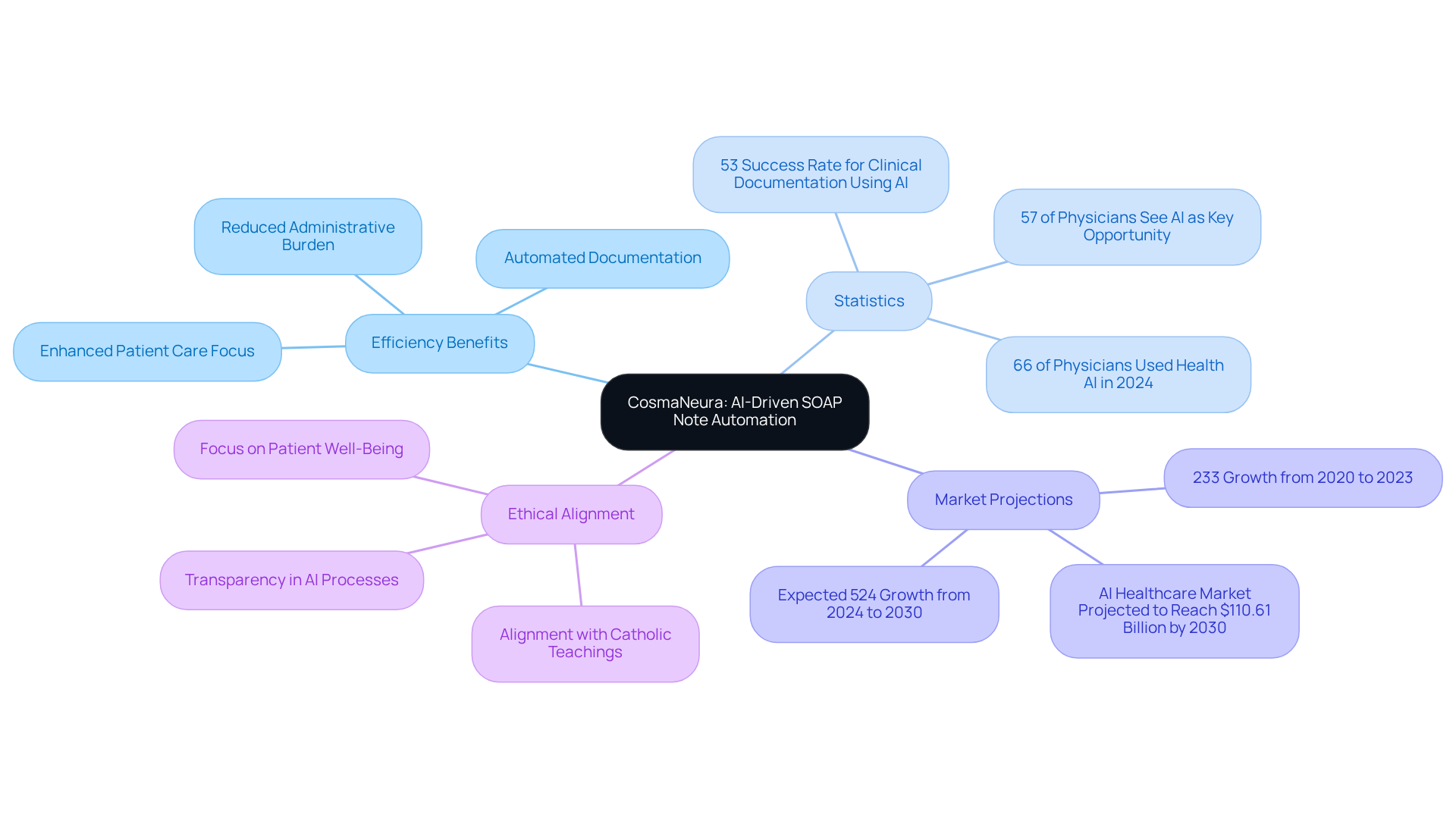
Heidi Health: Comprehensive SOAP Note Template with Practical Examples
Heidi Health understands the emotional challenges that healthcare providers face in their daily practice. With a comprehensive SOAP note template, it provides a SOAP objective example along with practical examples for each section: Subjective, Objective, Assessment, and Plan. This organized method allows you to systematically gather crucial information about individuals, ensuring that all pertinent details are recorded.
Research indicates that implementing structured documentation can significantly enhance outcomes for individuals. For instance, a study found that adherence to documentation quality increased from 38.2% to 87.2% after introducing structured practices. By utilizing such templates, healthcare providers not only improve the quality of their documentation but also foster better communication among care teams, ultimately leading to more effective care for individuals.
To maximize the benefits of template formats, it's essential to ensure clarity and brevity, emphasize critical details, and regularly assess records for accuracy. Examples of enhanced client outcomes through the use of SOAP objective examples highlight their effectiveness in improving clinical records and promoting continuity of care.
Moreover, by leveraging generative AI, you can automate the documentation process, alleviating the administrative burden associated with note-taking. This allows clinicians to focus more on client interactions, enhancing the overall quality of care. AI-driven tools can assist in evaluating individual data, ensuring that the information recorded in clinical summaries is thorough and precise. Ultimately, this leads to improved health results and more efficient workflows.
Are you ready to embrace these solutions and transform your documentation practices? Together, we can create a more compassionate and effective healthcare environment.
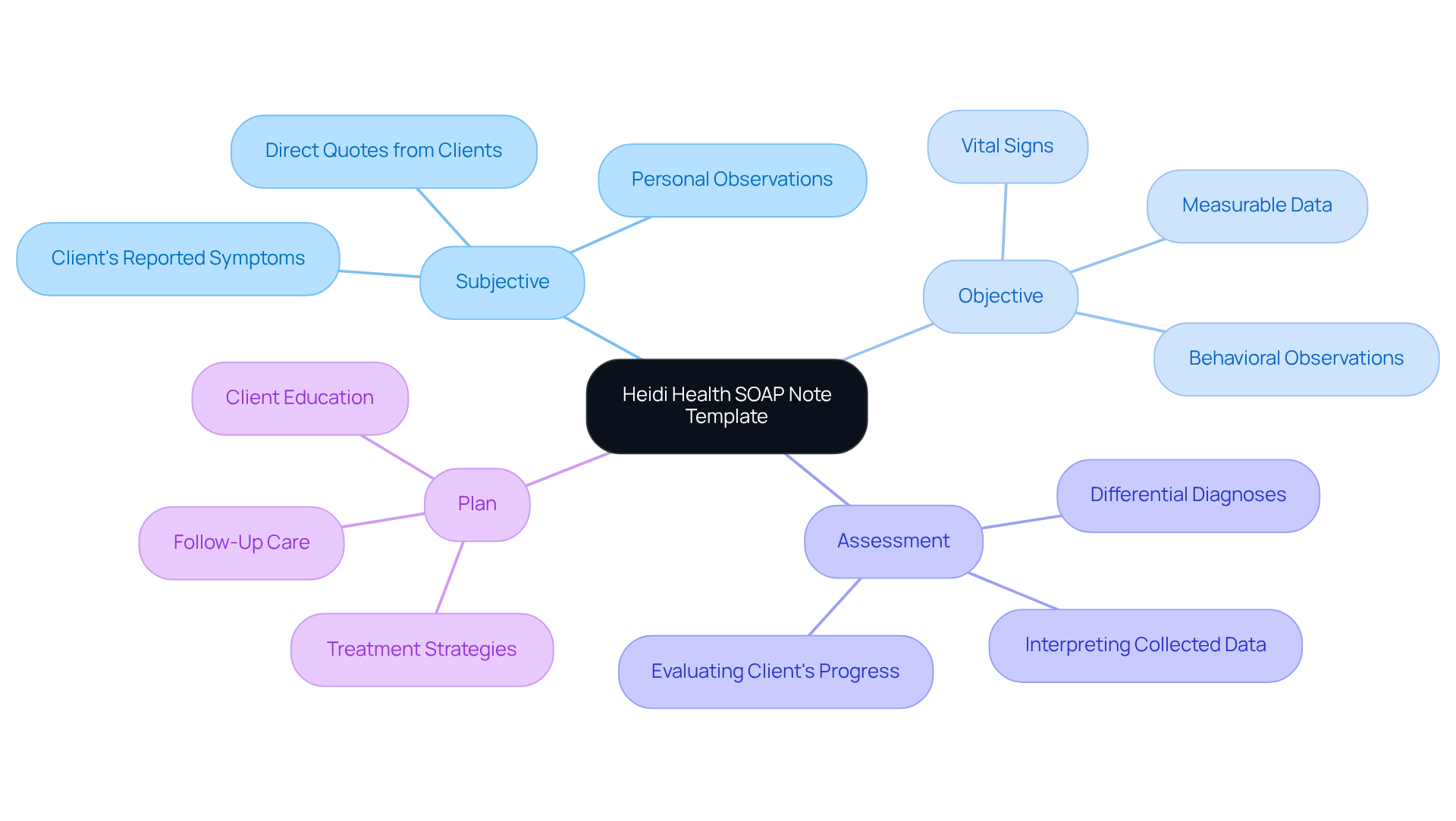
Mentalyc: Tailored SOAP Note Examples for Mental Health Practitioners
Mentalyc understands the emotional challenges faced by mental health professionals. Our specialized SOAP objective example documents are designed to address the complexities of mental health evaluations, encapsulating emotional states, therapeutic interventions, and individual progress. This ensures that records accurately reflect the unique experiences of each person. By utilizing these customized observations, mental health practitioners can enhance the clarity and effectiveness of their records, which is essential for formulating comprehensive treatment plans.
Imagine how much smoother your documentation process could be. This approach not only fosters the involvement of individuals receiving care but also promotes improved treatment outcomes. Clear and organized documentation aids communication among healthcare providers, guaranteeing continuity of care. For instance, integrating specific emotional conditions into your documentation can lead to more focused interventions, ultimately creating a more nurturing therapeutic atmosphere.
As a result, practitioners can look forward to significant improvements in patient satisfaction and treatment efficacy. We invite you to explore these resources and consider how they can support your practice. Together, we can enhance the quality of care provided to those who need it most.
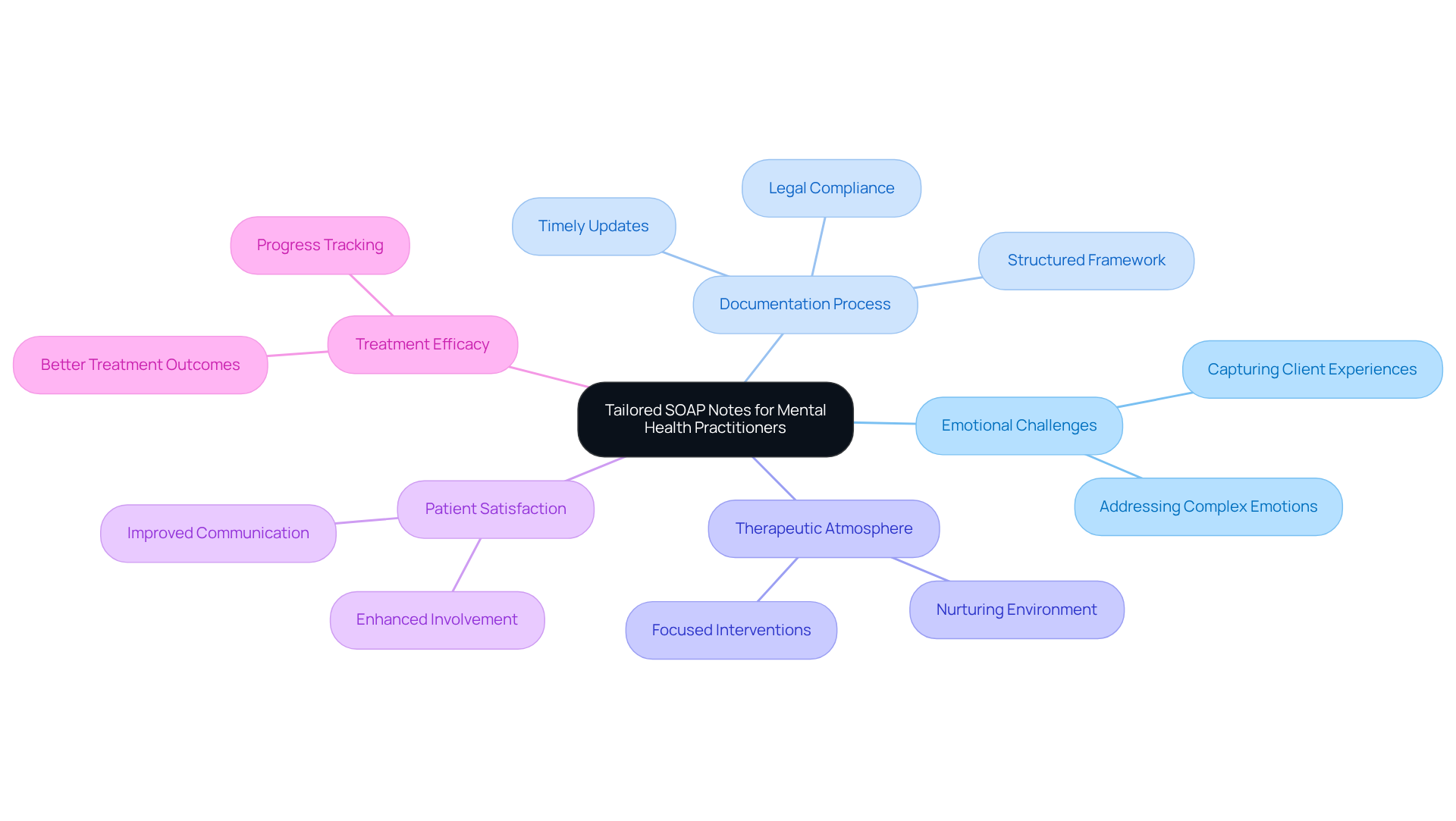
SimplePractice: User-Friendly Guide to Writing Effective SOAP Notes
Healthcare providers often face overwhelming challenges, especially when it comes to managing clinical documentation. SimplePractice offers a compassionate manual that simplifies the process of creating effective clinical records. This guide thoughtfully breaks down each component of the SOAP format, providing helpful tips and relatable examples, including a SOAP objective example, that empower healthcare professionals to produce clear and concise documentation. By following this guide, clinicians can enhance their record-keeping skills, ensuring their notes are not only compliant but also beneficial for patient care.
In today’s evolving healthcare landscape, it’s crucial to adapt record-keeping practices to meet contemporary challenges, such as telehealth and remote monitoring. Additionally, training in effective documentation techniques can significantly improve healthcare provider performance. Studies have shown that professionals educated in routine practice recording are 4.2 times more likely to document their practices effectively. To foster efficient documentation, providers should focus on clarity and conciseness, utilizing bullet points for the SOAP objective example and a narrative format for the Subjective part.
Examples of effective clinical record-keeping illustrate how to gather essential patient details succinctly, ultimately enhancing communication and continuity of care among healthcare teams. However, it’s important to acknowledge that healthcare workers often face obstacles like high client flow and time constraints, which can hinder their documentation efforts. Understanding the legal and ethical aspects of documentation is also vital for maintaining compliance and ensuring quality patient care.
By embracing these strategies, healthcare providers can alleviate some of the burdens they face, leading to improved patient outcomes and a more manageable workflow. Let’s continue to support one another in navigating these challenges together.
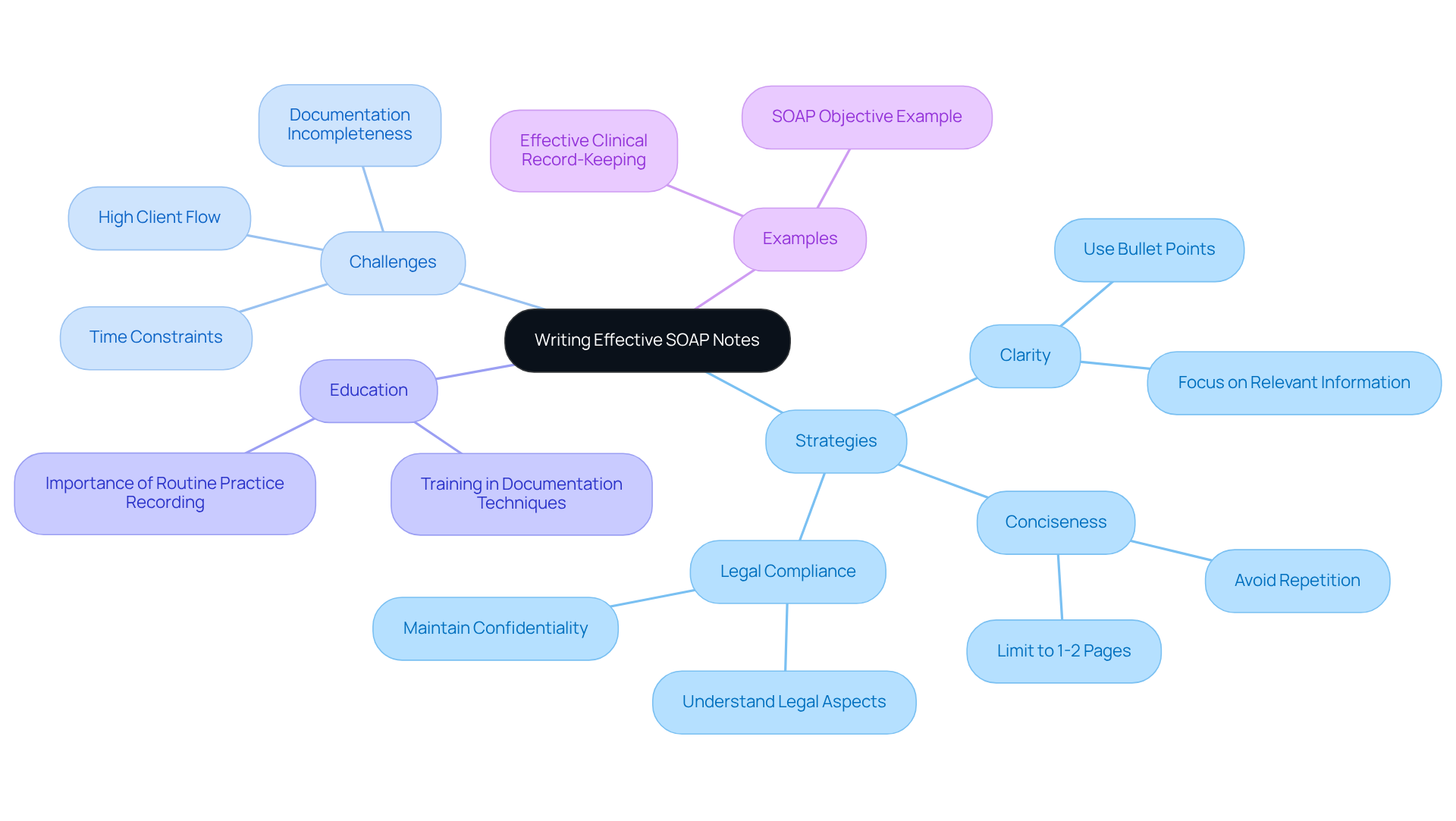
SonderMind: Best Practices for Effective SOAP Note Documentation
SonderMind recognizes the emotional challenges that healthcare providers face, particularly when it comes to maintaining effective SOAP objective example records. The administrative burdens can feel overwhelming, but there are best practices that can make a significant difference. By emphasizing clarity, conciseness, and relevance, providers can alleviate some of that stress. Using standardized terminology and avoiding jargon ensures that notes are easily understandable by other healthcare providers, fostering better communication.
Research shows that structured records can dramatically improve the Qnote quality score, rising from a mean of 64.35 to 77.2. This highlights the positive impact that clarity and organization can have on the quality of records. Elaf Abdelrahman Abdelrahim emphasizes that precise and organized clinical documentation is essential for delivering high-quality care. By following these best practices, clinicians not only enhance the usefulness of their documentation but also promote improved collaboration and continuity of care, providing a clear soap objective example.
It’s crucial to recognize that mistakes in documentation can negatively impact client outcomes and the reputation of healthcare practices. A comprehensive approach to record keeping not only streamlines communication but also supports better patient outcomes. By embracing these practices, healthcare providers can take meaningful steps towards improving their documentation, ultimately benefiting both themselves and their patients.
Key Recommendations:
- Use standardized terminology.
- Avoid jargon.
- Ensure notes are clear and concise.
By implementing these strategies, you can enhance your documentation and foster a more supportive environment for patient care. Let’s work together to create a system that prioritizes clarity and compassion.
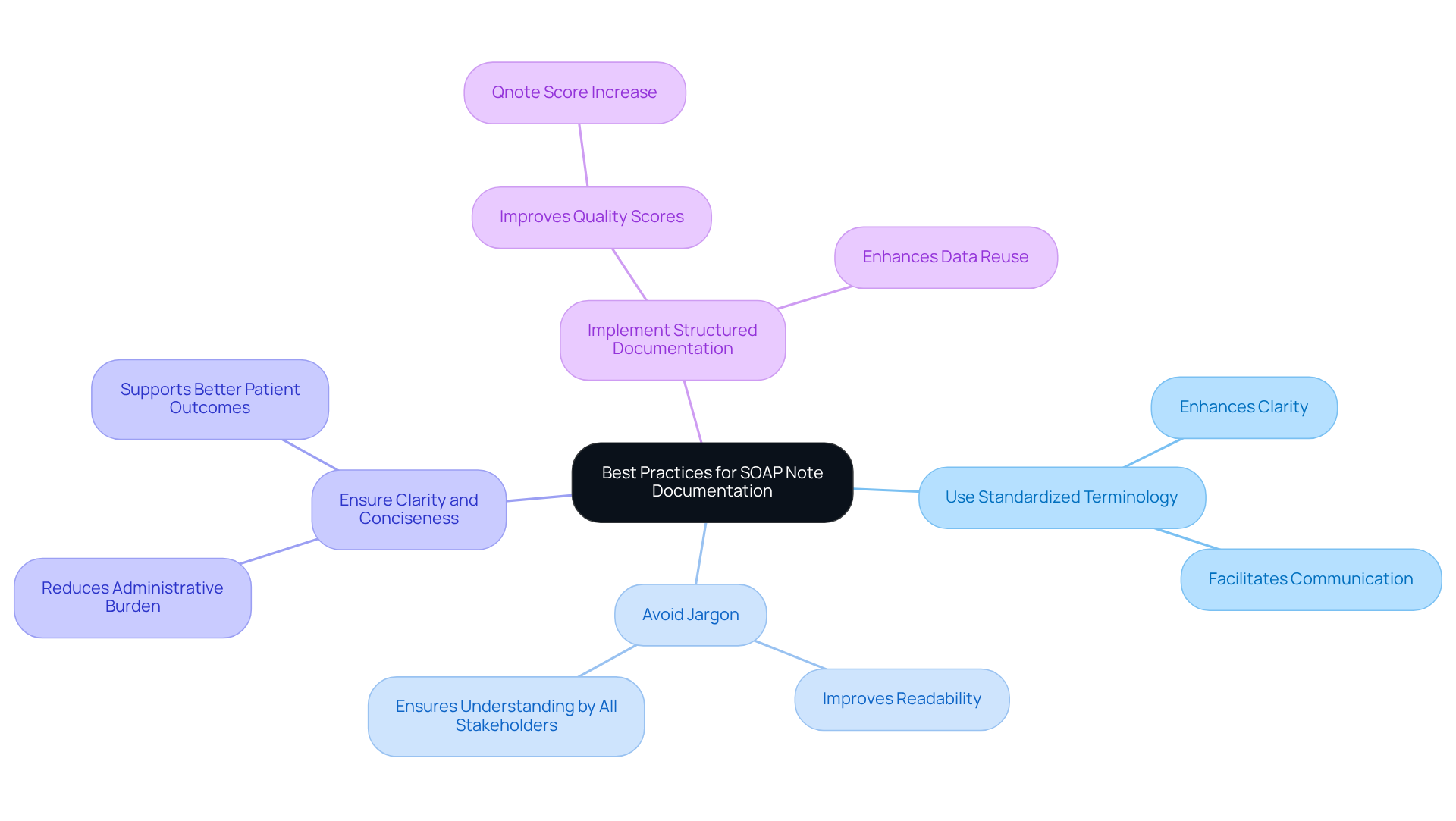
Psylio: SOAP Note Examples for Diverse Therapy Types
Efficient records are not just vital in therapy; they are essential in addressing the emotional challenges faced by healthcare providers. Structured entries serve as a standardized way to capture crucial information across various therapeutic methods, including cognitive-behavioral therapy and family therapy. By utilizing customized documentation examples, practitioners can accurately represent the unique elements of each intervention, ensuring their records meet the specific needs of their clients.
Consider the practical uses of this documentation. In cognitive-behavioral therapy, the subjective section may capture a client's feelings of anxiety, while the objective section serves as a SOAP objective example by documenting observable behaviors, such as restlessness or rapid speech. This organized approach not only enhances clarity but also supports effective treatment planning and strategy modification, as SOAP objective examples serve to document both subjective experiences and objective observations.
Best practices for documenting therapy sessions underscore the importance of concise and clear records. Practitioners should strive for precise language, steering clear of overly long narratives that may obscure critical information. By focusing on clarity, brevity, and evidence-based observations, therapists can produce records that are defensible, accurate, and compliant with legal standards.
The impact of customized documentation on therapy session outcomes is significant. Research shows that 50% of clients experience improved symptoms after just eight sessions of mental health treatment, with 75% seeing substantial improvements by six months. This underscores the importance of efficient documentation in monitoring progress and recognizing trends over time, further supporting the use of structured records in therapy documentation.
In summary, applying best practices in documentation not only enhances the quality of care but also promotes operational efficiency in private practice. By effectively recording various therapy types, practitioners can ensure their records contribute to better therapeutic outcomes and foster a deeper understanding of their clients' needs.
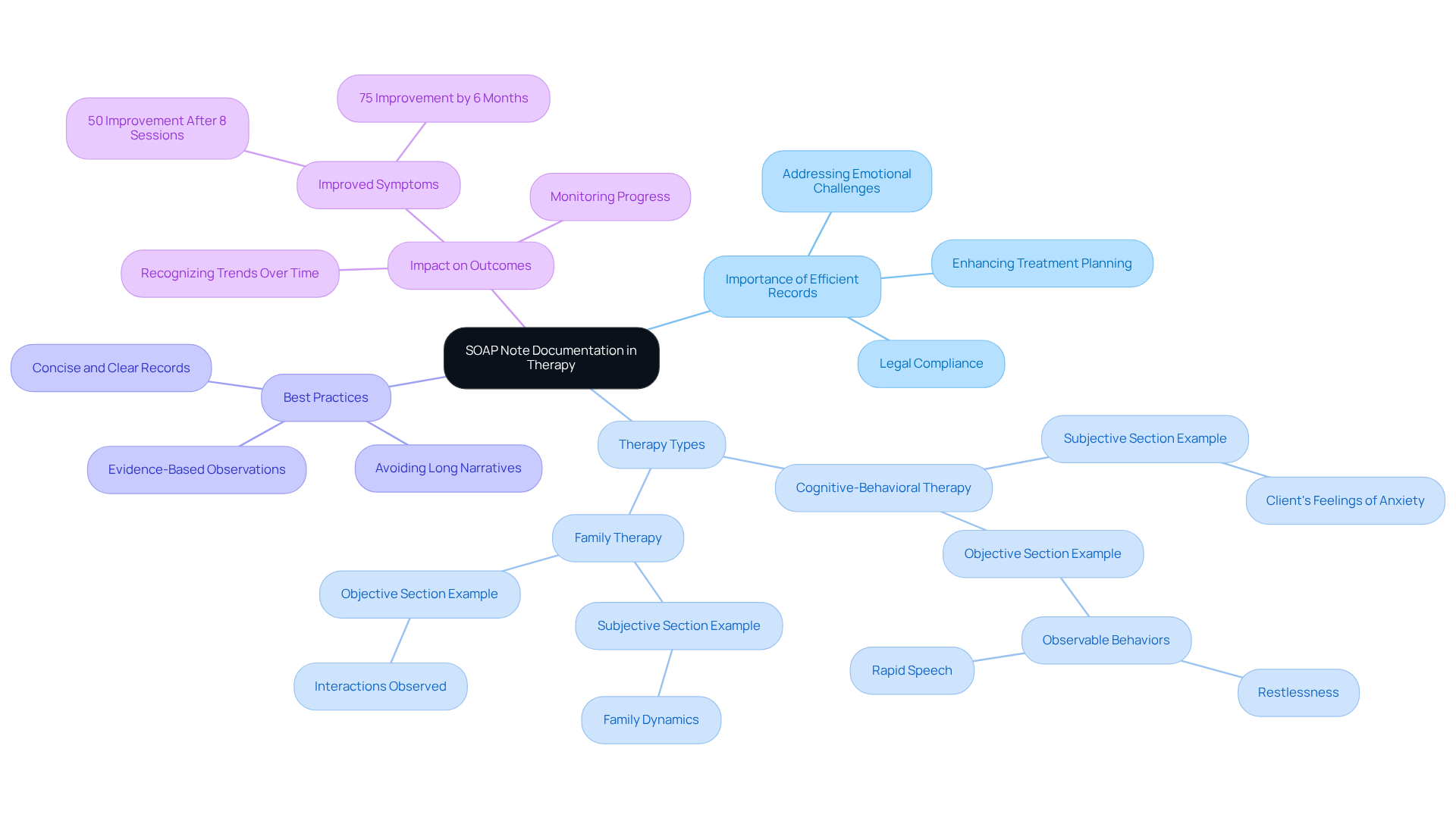
NCBI: Academic Insights on the Clinical Significance of SOAP Notes
In the demanding world of healthcare, providers often face emotional challenges that can impact patient care. Organized documentation is not just an administrative task; it is a lifeline that enhances communication among professionals and ultimately improves the experience for patients. The structured layout of SOAP objective example records significantly aids in thorough reporting, ensuring that no detail is overlooked in treatment planning and continuity of care.
Research shows that organized records can lead to a remarkable 20% enhancement in record quality. This improvement greatly boosts the clarity and thoroughness of clinical entries, allowing clinicians to monitor progress more effectively. Have you ever wondered how much easier it would be to make informed decisions with clear documentation? This organized approach not only enhances clinical outcomes but also prioritizes the safety of individuals.
Additionally, the use of organized clinical records has been linked to a staggering 75% improvement in lab results recording. This showcases their efficacy in capturing essential client information that can be crucial for timely interventions. By embracing the knowledge surrounding clinical documentation, healthcare professionals can gain a deeper understanding of their vital role in promoting enhanced patient care and safety.
Let us reflect on how organized documentation can alleviate some of the burdens we face. By prioritizing structured records, we can foster a more supportive environment for both patients and providers alike. Together, we can make a meaningful impact on the quality of care we deliver.
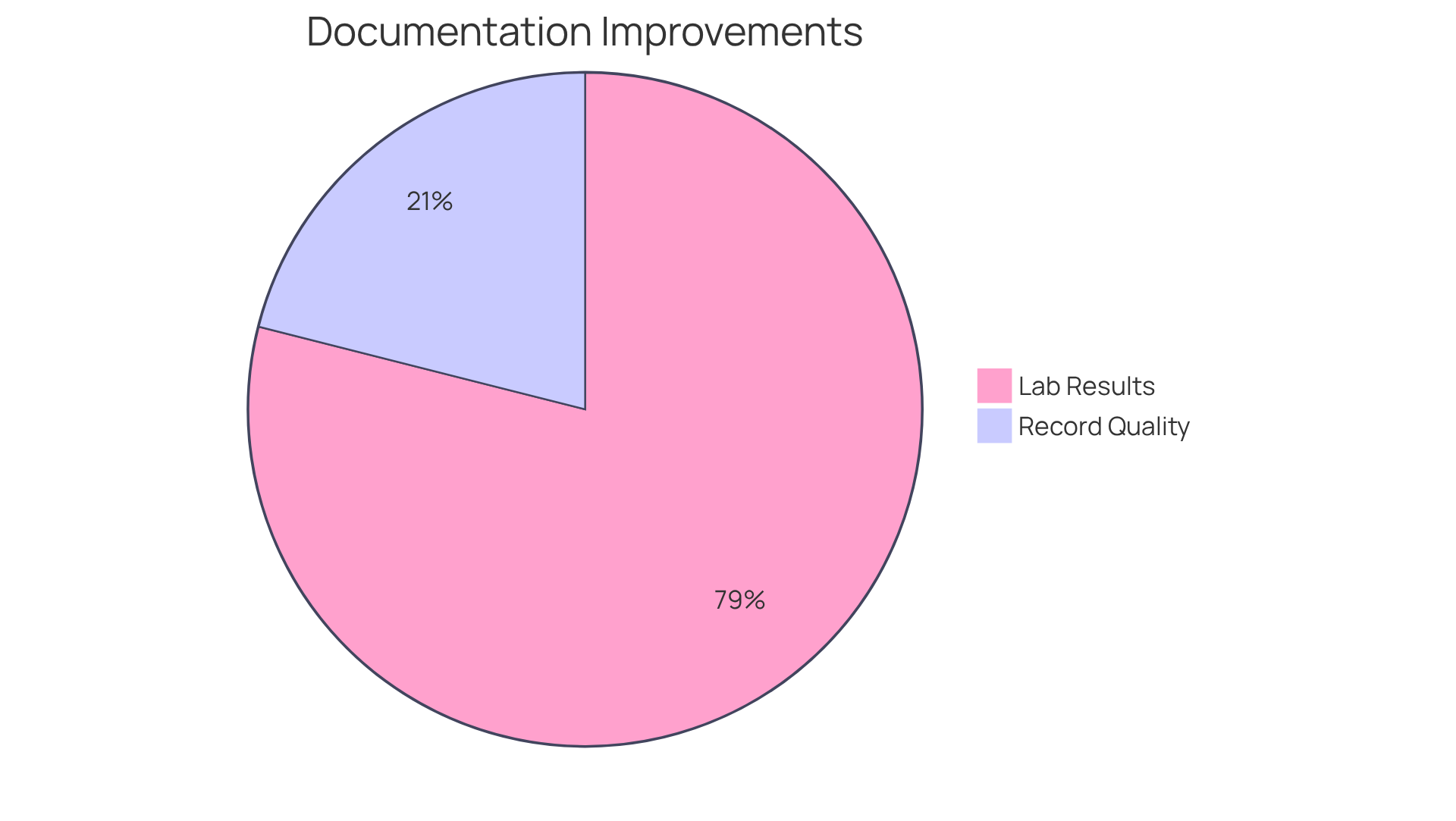
Headway: Compliance Benefits of Using SOAP Notes in Clinical Practice
In the demanding world of healthcare, providers often face emotional challenges related to compliance and documentation. Headway highlights the compliance advantages of structured documentation, emphasizing its crucial role in meeting regulatory obligations and ensuring accurate records. Have you ever felt overwhelmed by administrative tasks? By employing structured documentation, healthcare professionals can demonstrate compliance with best practices and legal requirements, significantly reducing the risk of audits and fines.
This proactive approach not only safeguards your practice but also elevates the quality of care you provide to your patients. Imagine the peace of mind that comes with knowing your documentation is in order. HealthOrbit AI plays a vital role in this journey, offering organized documentation that strengthens compliance and legal protection. The use of structured documentation has been proven to improve audit outcomes, serving as essential legal documentation that clarifies matters during audits and legal reviews.
Moreover, the implementation of the APSO format reflects the evolving preferences of clinicians, further validating the effectiveness of structured documentation in today's healthcare environments. Let’s embrace these tools together, ensuring that we can focus more on what truly matters—providing exceptional care to our patients.
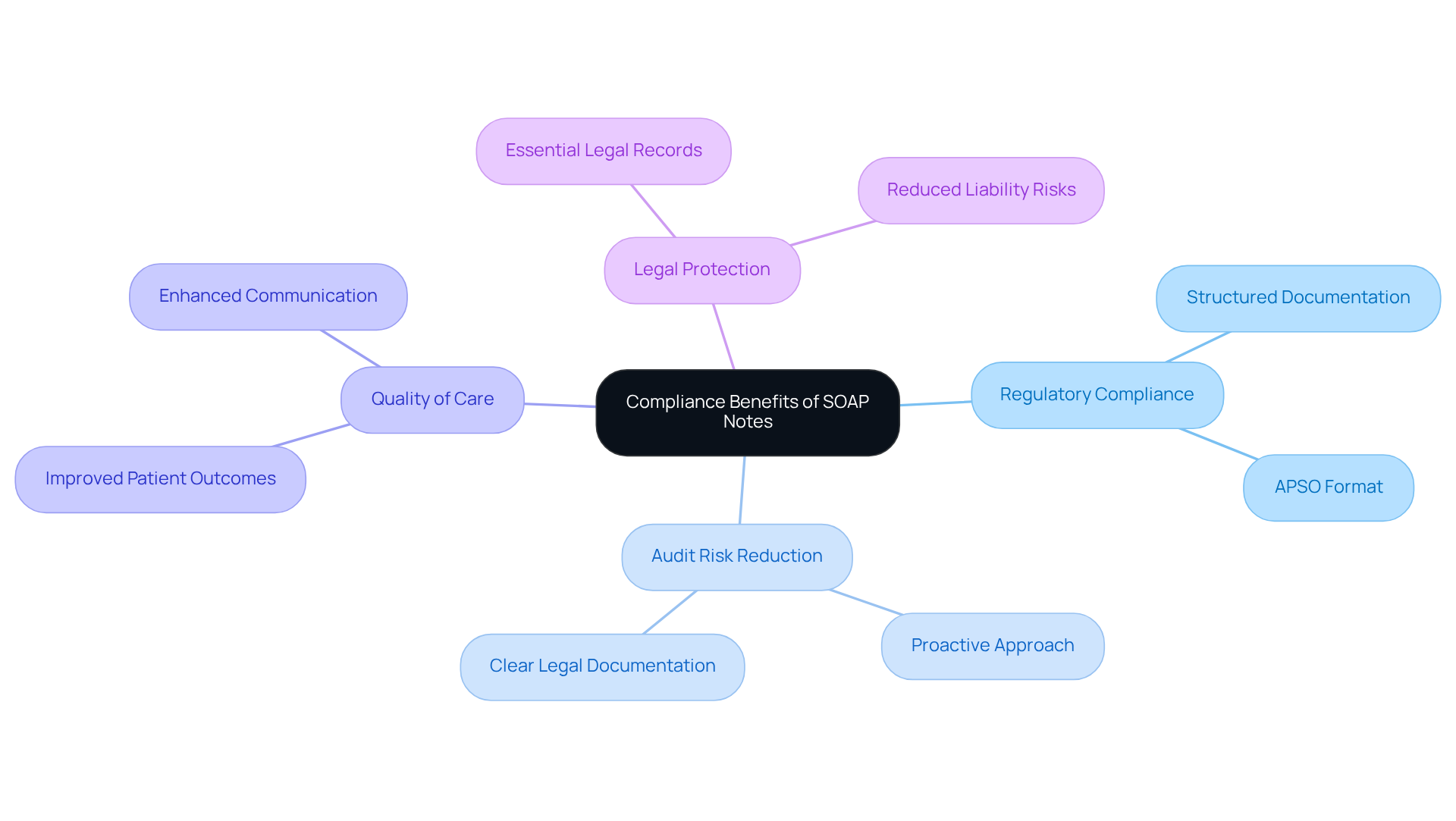
Mentalyc: Enhancing Collaborative Care Through Structured SOAP Notes
Organized documentation, such as a soap objective example, is vital for improving collaborative care among healthcare providers. It addresses the emotional challenges faced by many in the field, offering a clear and consistent structure for records that fosters effective communication within the care team. This organized approach ensures that all providers have access to the same information, which serves as a soap objective example essential for coordinated care and better patient outcomes.
Research reveals that organized records significantly enhance the quality of notes, with scores improving from an average of 64.35 to 77.2 after implementation. This notable increase indicates a marked enhancement in clarity and completeness, alleviating some of the administrative burdens that can impact patient care. Furthermore, the use of organized records has been shown to reduce variability in the quality of written materials, leading to safer care and minimizing the chances of mistakes during transitions.
As the healthcare landscape continues to evolve, the trend toward standardized record-keeping practices becomes increasingly important. It not only fosters effective communication and collaboration among providers but also enhances the overall quality of care delivered to patients. By embracing these organized approaches, we can support each other in overcoming common challenges in the healthcare field, ultimately creating a nurturing environment for both providers and patients alike.
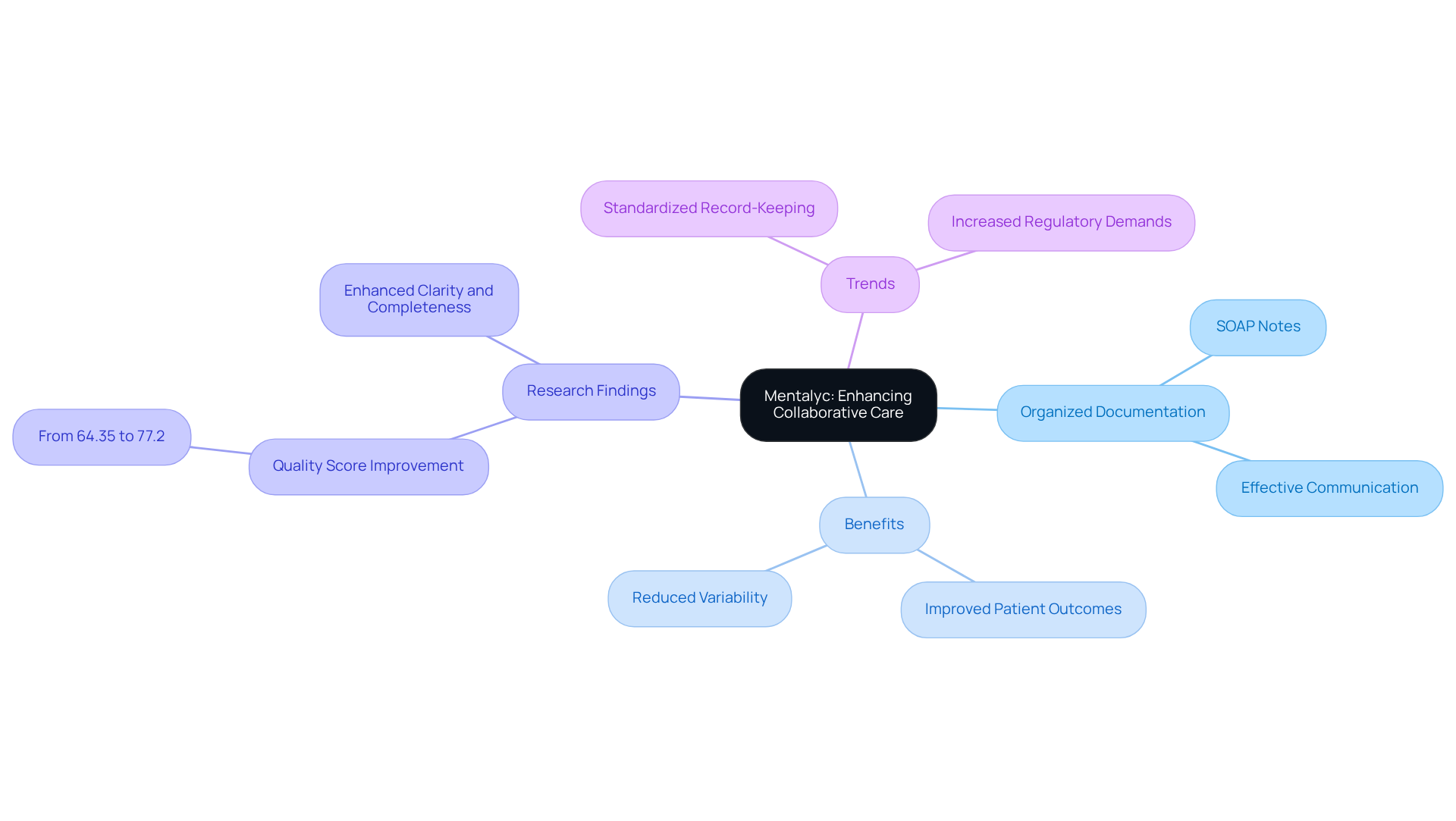
Heidi Health: Historical Context and Development of SOAP Note Templates
Heidi Health offers a compassionate look into the historical context of documentation templates. By tracing their evolution from simple recording techniques to the organized formats we see today, we can better understand the emotional challenges healthcare providers face. This historical perspective highlights the critical role documentation plays in modern healthcare, addressing the changing needs of clinical practice.
Have you ever felt overwhelmed by administrative tasks? The evolution of documentation has aimed to lighten this burden, ultimately enhancing patient care. Understanding this journey allows healthcare providers to see the true value of the SOAP objective example, as it is designed to streamline processes and improve outcomes.
By embracing this evolution, you can appreciate how these tools enhance your ability to provide compassionate care. Let’s continue to explore how we can support one another in navigating these challenges together.
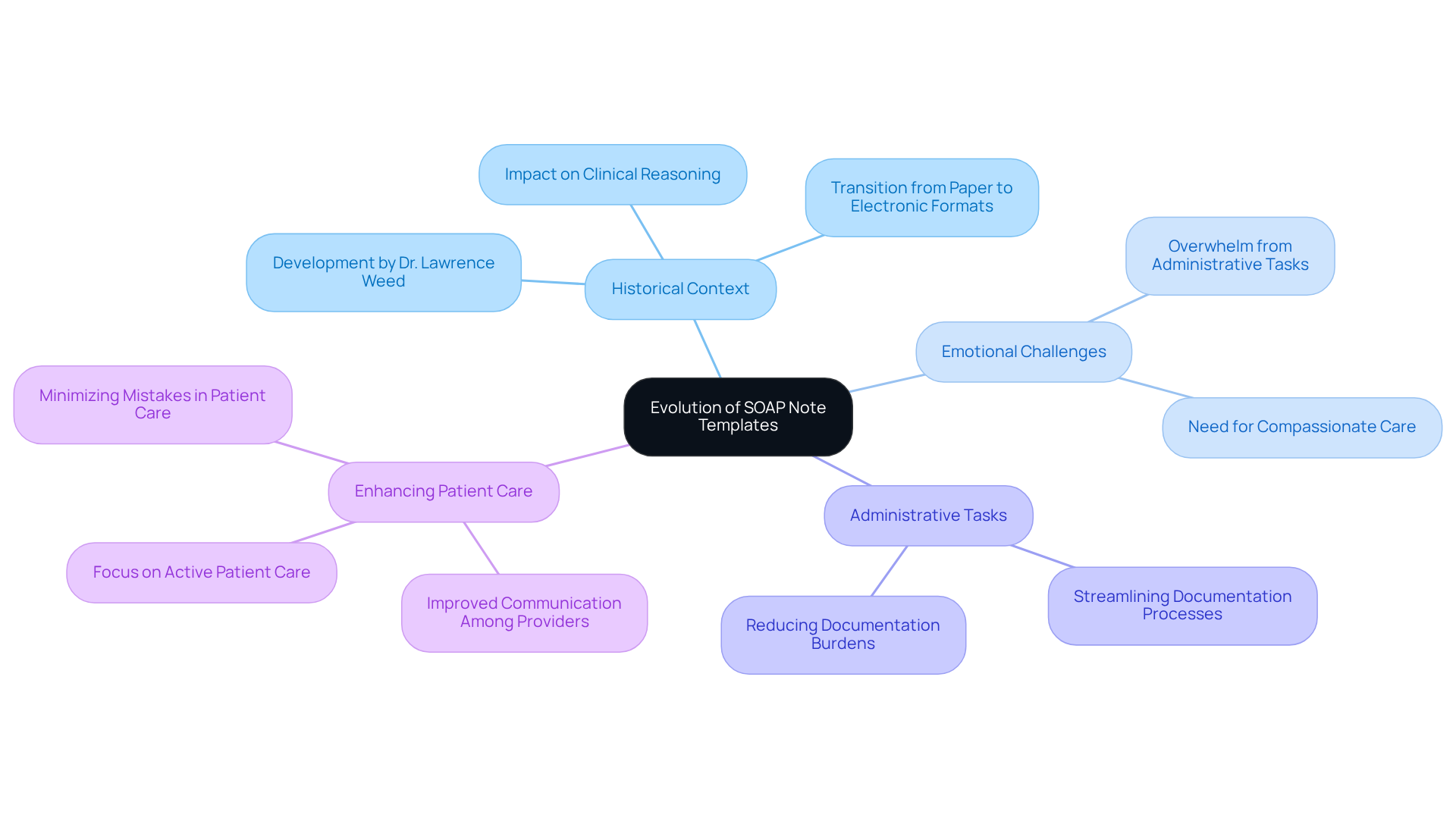
Conclusion
Integrating structured SOAP notes into clinical documentation is not just essential; it’s a compassionate response to the emotional challenges faced by healthcare providers. By adopting these systematic approaches, professionals can alleviate administrative burdens, allowing them to focus more on meaningful patient interactions and outcomes. The clarity, organization, and compliance foster a supportive environment for both providers and patients, promoting a sense of care and connection.
Throughout this discussion, we’ve explored various tools and methodologies, such as:
- AI-driven solutions like CosmaNeura
- Comprehensive templates from Heidi Health
- Tailored examples for mental health practitioners
Each resource underscores the transformative potential of structured documentation in enhancing clinical outcomes, reducing physician burnout, and ensuring compliance with regulatory standards. It's clear that effective documentation practices lead to improved patient satisfaction and a higher quality of care.
In conclusion, embracing structured SOAP notes transcends mere administrative convenience; it is a vital step towards nurturing a compassionate and effective healthcare environment. By prioritizing organized documentation, healthcare providers can meet the evolving demands of their practice while enhancing the quality of care delivered to patients. So, let’s take action together to implement these strategies, ultimately creating a more efficient, collaborative, and patient-centered healthcare system.




